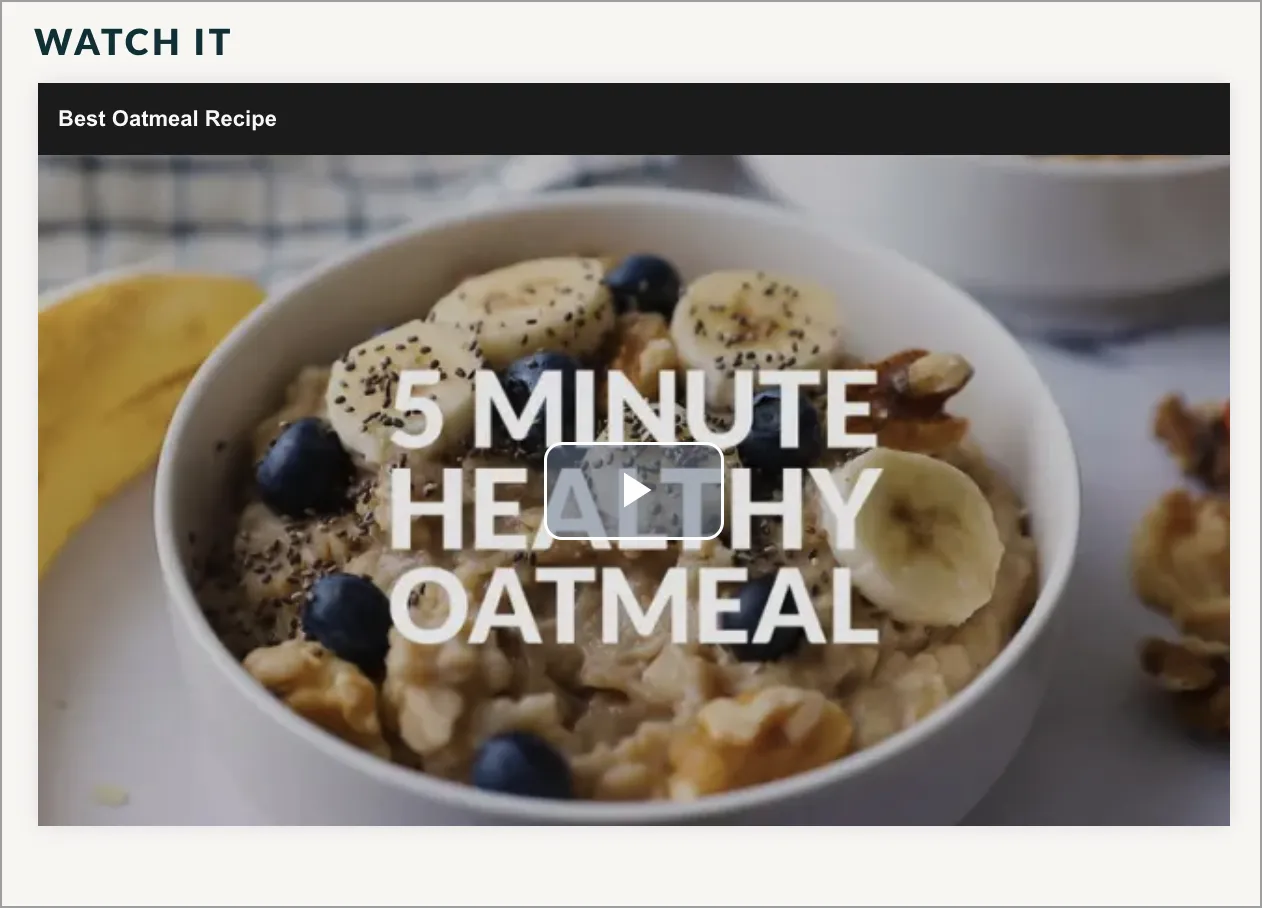
SEO for beginners – start with the basics
Jessica Baldwin / Published July 27, 2023
Do you ever wonder why some websites are on the first page of search results while yours is buried deep in the abyss? As a new website owner, it's only natural to want your website to rank higher on Google and other major search engines. But when you start researching search engine optimization (SEO), it's easy to become overwhelmed by all the advice. Hiring SEO help can also be a significant investment, especially for startup businesses.
But fear not! There are several SEO for beginners steps you can take to give your website a good foundation. And the best part? You don't need to be an SEO expert or spend a fortune.
What is SEO?
SEO, or search engine optimization, is a set of techniques used to optimize your web pages with the goal of ranking higher on search engines. When someone searches for a product or service related to your business, you want your website to appear on the first page of the search results.
SEO involves several tactics, such as using target keywords, creating high-quality and relevant content, building links, and improving user experience. By implementing these techniques, search engines can recognize the value and relevance of your website, ultimately boosting its visibility.
SEO is not a one-time task but an ongoing process. It requires continuous effort and monitoring to stay ahead of the competition and adapt to changing search engine algorithms. SEO can help drive organic traffic from search engines.
Elements of SEO
When it comes to improving your website's visibility on search engines like Google, there are various tactics you can use as part of your SEO strategy.
One important distinction is the difference between on-site and off-site SEO tactics. On-site SEO focuses on optimizing elements within your website, such as using relevant keywords, creating high-quality content, and ensuring a positive user experience. This includes strategies like keyword research, creating meta descriptions, and using internal links.
Off-site SEO, on the other hand, refers to tactics done outside of your website to improve its visibility. This includes activities like external link building, where you seek to have reputable websites link back to your content and optimizing your business listings across the web to increase brand awareness and drive traffic to your site.
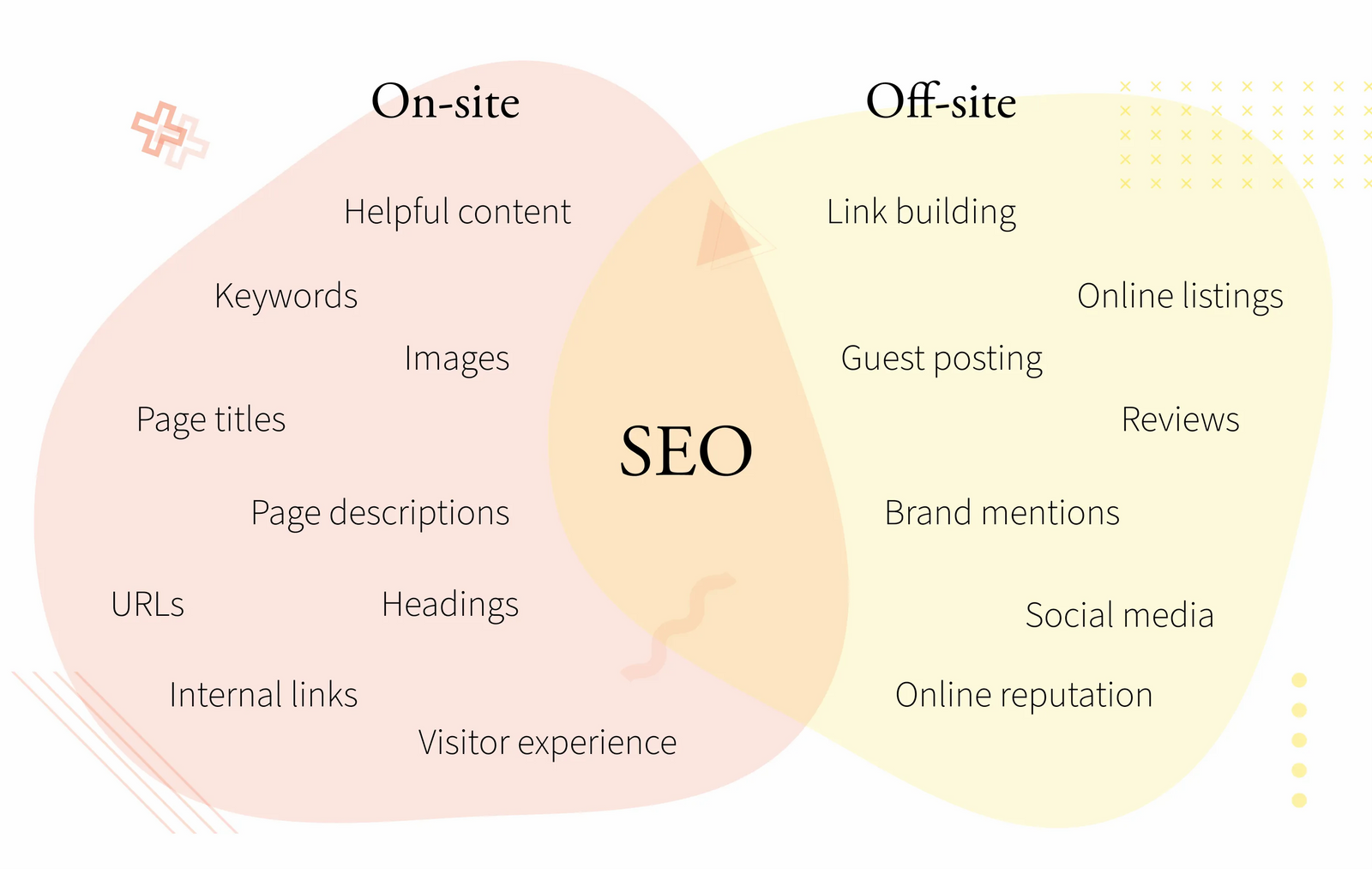
Combining on-site and off-site SEO tactics can improve your website's organic search traffic and rankings. It's important to remember that search engines use complex algorithms to determine rankings, so it's essential to focus on creating relevant content, using keywords intelligently, and building a robust online presence.
Key understandings
Before diving into the world of search engine optimization, let's establish some essential understandings that will help you navigate this complex landscape.
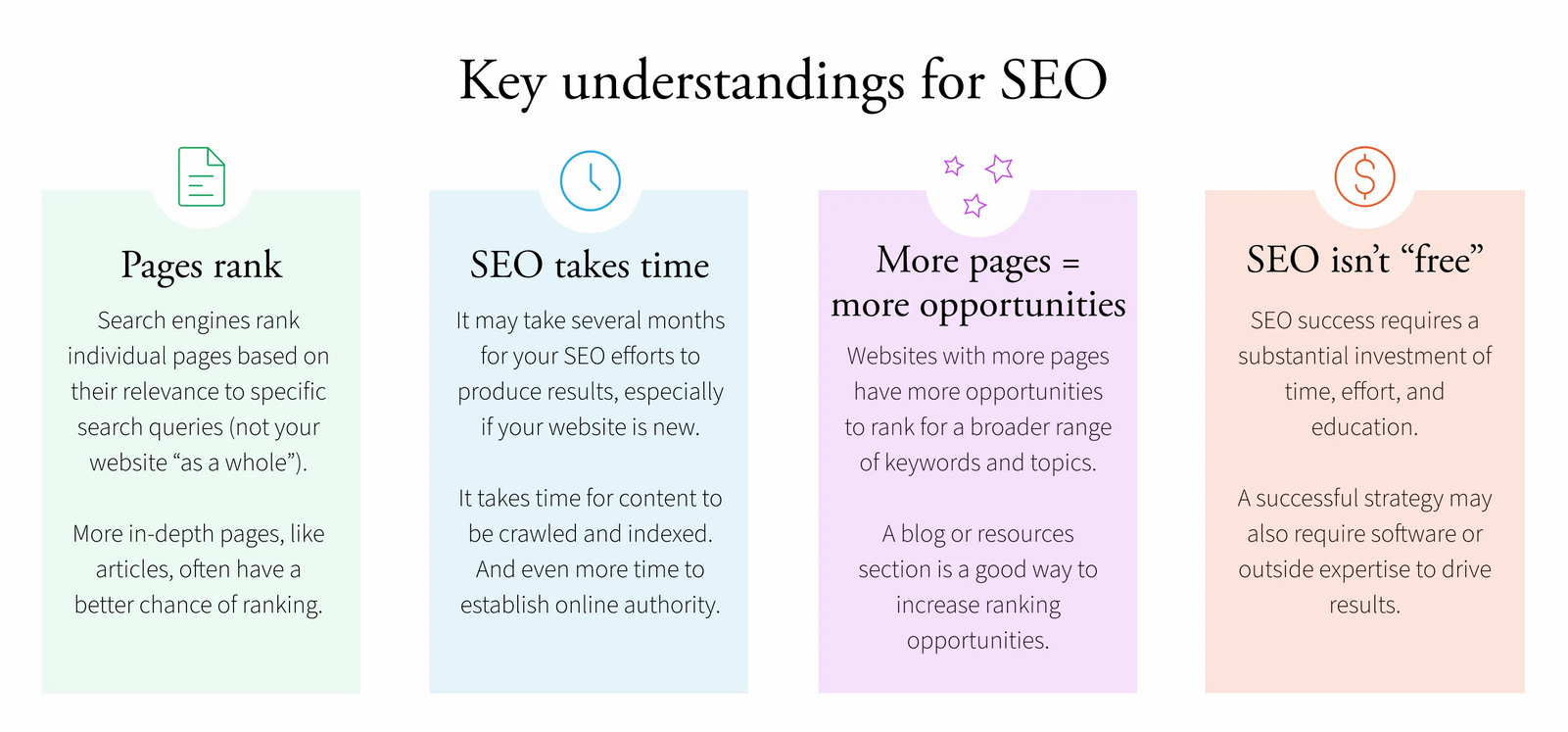
Web pages rank, not websites
It's a common misconception to believe that optimizing your website "as a whole" will automatically lead to better rankings for all relevant keywords. Many business owners mistakenly assume that if their website is well-optimized, their homepage will automatically show up for any search related to their business. However, in reality, search engines rank individual pages based on their relevance to specific search queries, considering factors such as keyword density, the information provided, and the searcher's intent.
For example, let's consider a small bakery with a website featuring an article titled "The Best Chocolate Cake in [Location]." The article showcases the bakery's renowned chocolate cake and discusses its infamous recipe. It features glowing reviews from satisfied customers, all highlighting its excellence. If a user searches for "best chocolate cake in [location]," the search engine is more likely to display the article rather than the bakery's homepage. This is because the article is exclusively dedicated to the target keyword, "best chocolate cake in [location]." Its high keyword density, recipe information, and alignment with the user's search intent make it a more relevant and valuable resource to display.
SEO takes time
Another vital understanding of SEO is that it takes time to see significant results. Especially for new websites, building a solid online presence and achieving higher rankings on search engines will be gradual. Unlike established websites with a recognized online reputation, new websites start from scratch and need to earn the trust of search engines and users alike. It takes time for search engines to crawl and index new website content and even longer to establish authority and credibility in the eyes of search algorithms. Patience and consistent effort are key as you work on creating valuable content, building high-quality backlinks, and engaging with your target audience. By focusing on organic growth and understanding that SEO is a long-term strategy, new websites can steadily compete with more established counterparts and gradually climb the search engine rankings.
Websites with more pages have more opportunities to rank
Websites with more pages have more opportunities to rank for a broader range of keywords and topics. Each web page on your site can be optimized to target different relevant keywords and provide valuable content. Having more pages means you can cover a diverse range of topics related to your business, products, or services, catering to a larger audience and increasing your chances of being found in search results.
An ongoing content strategy will help you increase the number of pages on your website. By creating a content strategy, you can consistently produce valuable and engaging content that aligns with your target audience's interests and search intent. A comprehensive strategy may include blog posts, articles, videos, guides, and other forms of content that address your audience's needs and queries.
Regularly publishing fresh, informative, and keyword-optimized content can attract organic traffic, encourage user engagement, and signal search engines that your website is relevant and active.
SEO isn't "free"
While SEO can yield significant long-term benefits, it's important to recognize that it isn't a "free" marketing strategy. SEO success requires a substantial investment of time, effort, and expertise. While you can get started with the basics, eventually, you may need the help of an expert to accelerate your search engine rankings which will require a monetary investment.
Waiting several months for SEO efforts to generate customers for new businesses can be financially challenging. Quick marketing results are crucial to gaining momentum and establishing a solid customer base. So, supplement your SEO efforts with other marketing strategies like pay-per-click (PPC) advertising, email marketing, social media, or outbound sales. These channels may yield quicker traction initially. In contrast, SEO's long-term potential lies in building a sustainable flow of organic traffic and improved search engine rankings.
Embrace a balanced marketing approach to maximize your website's growth and success.
Start with SEO basics
SEO can be overwhelming at first. If you attempt to tackle everything at once, it's easy to become discouraged. So, begin with the basics of SEO and take it one step at a time. We recommend optimizing your website's core pages and developing an ongoing content strategy to start.
Optimize core pages
Optimizing your website's core pages, such as the homepage, service, product, about, and contact pages, is crucial for improving your website's ranking on search engines. By implementing various SEO practices on these pages, you can enhance their visibility and relevance to search engines, ultimately leading to higher rankings.
Optimize different elements to help your website's ranking:
Create descriptive page titles
Page titles (or meta titles) are displayed in the browser's title bar and serve as clickable headlines in search engine results.
Creating relevant and descriptive page titles that include target keywords helps search engines understand the content and context of your pages. It also influences how your pages are displayed in search results, increasing the likelihood of attracting clicks from users.
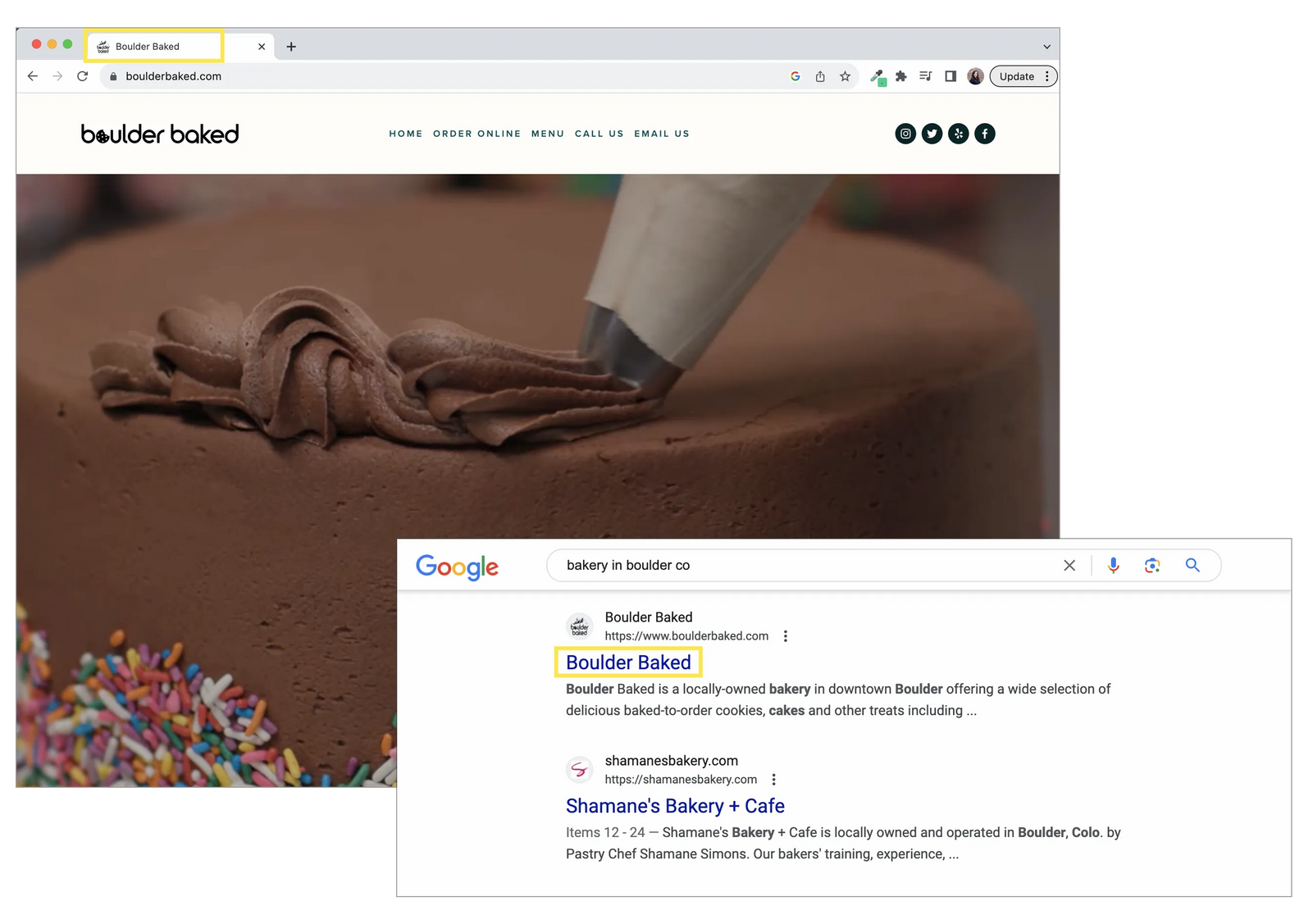
Depending on your website platform or content management system (CMS), you can input a custom page title for each web page while editing your website.
Craft keyword-rich, helpful page descriptions
Page descriptions (or meta descriptions) are short snippets of text displayed below the page title in search engine results. They serve as concise summaries of the content on a web page and provide additional context to users about what they can expect when they click through to the page.
Crafting compelling meta descriptions is essential because they play a vital role in attracting searcher clicks. While meta descriptions are not direct ranking factors, they can influence a page's click-through rate (CTR). A well-written meta description that includes relevant keywords and entices users to learn more can increase the likelihood of users clicking on your page in search results.
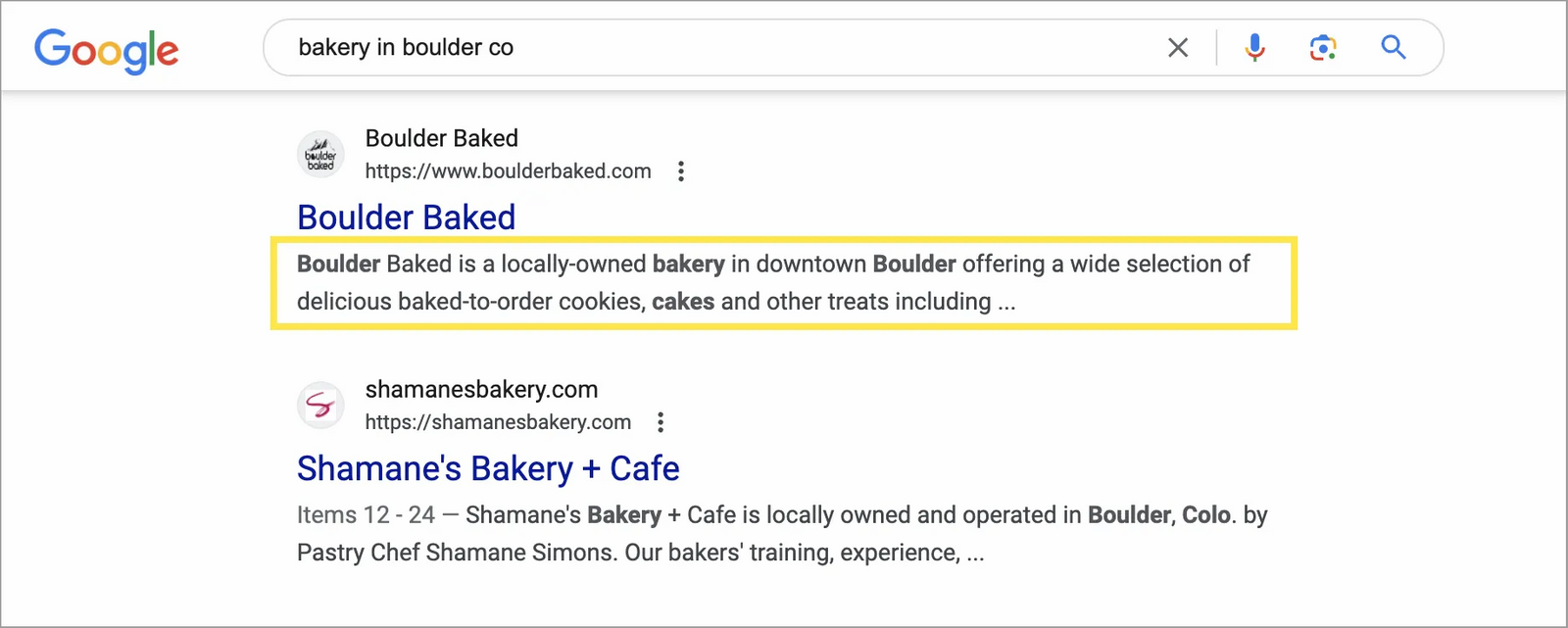
Like page titles, the website platform or content management system (CMS) you use will allow you to input custom meta descriptions for each web page. Taking advantage of this customization enables you to create engaging and informative meta descriptions that align with the content of your pages. By providing valuable insights in the meta description, you improve the chances of attracting relevant traffic to your website and enhancing your overall search engine visibility.
Optimize images with alt text
Optimizing images by adding alt text, descriptive file names, and reducing file sizes can improve your website's overall performance. This makes it easier for search engines to crawl and index your images, potentially appearing in image search results, which can drive additional traffic to your website.
For example, a bakery may include "Best chocolate cake in [location]" as alt text on an image of their chocolate cake.

Adding alt text to images on your website is simple. You can easily input custom alt text for each image using your website platform or content management system (CMS). This alt text should be descriptive and concise, accurately reflecting the content and purpose of the image. By doing so, you enhance accessibility for visually impaired users and provide valuable context for search engines, which can positively impact your website's overall performance.
Include relevant keywords
Including relevant keywords throughout your core pages helps search engines understand the topics covered on each page.
To determine keywords for your website:
- Conduct research using tools like Google Keyword Planner or the keyword research tool from seoreviewtools.com. You can also use paid tools from companies like SEMrush.
- Focus on relevance and use keywords naturally in titles, descriptions, and content.
- Avoid keyword stuffing, as search engines value user-friendly content.
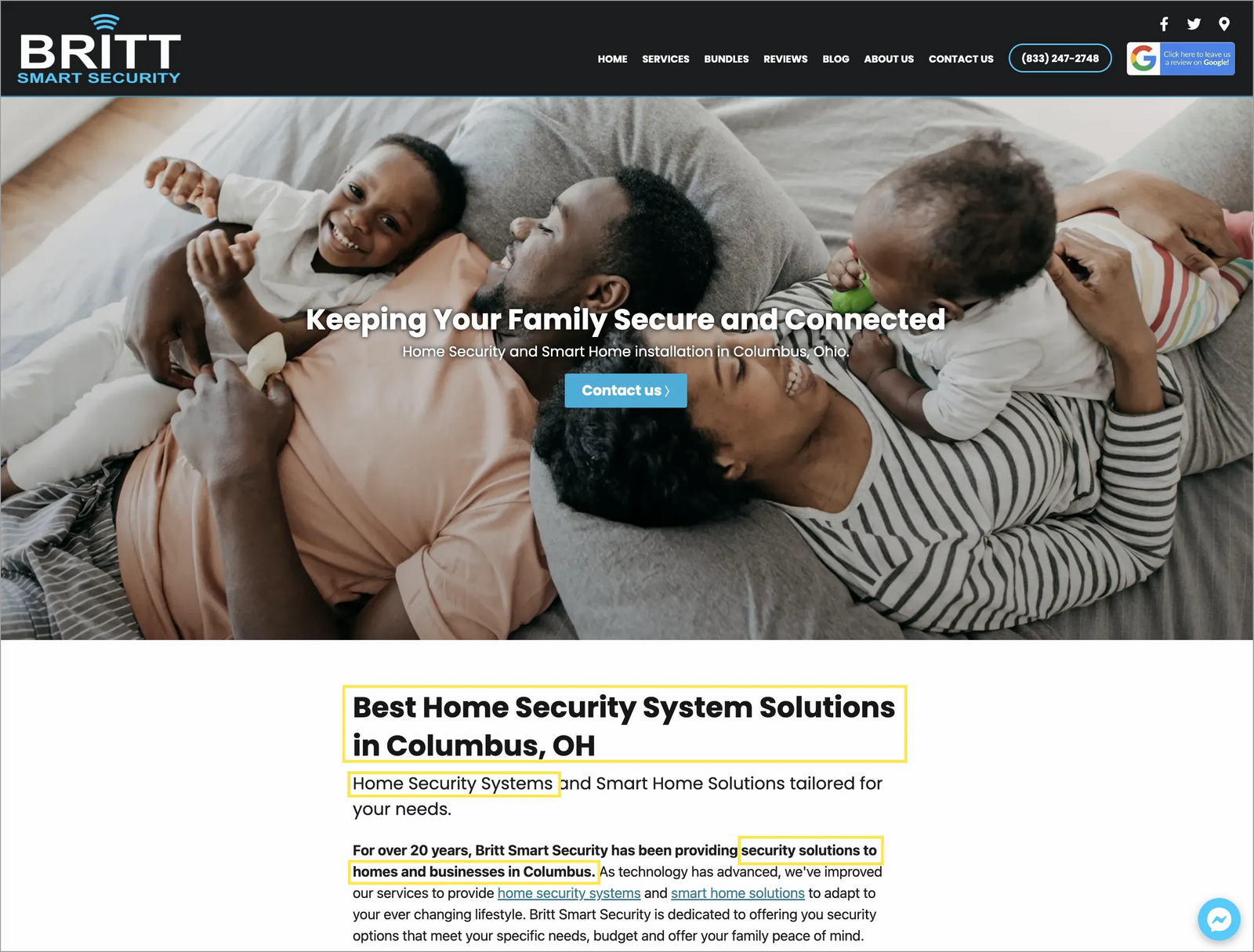
Utilize your website platform's page editing interface to update the text on each core page, incorporating relevant keywords. If you run a local business, include your business location or service area in the content. This practice enhances your chances of appearing in local search results, reaching potential customers in your vicinity. By strategically optimizing your core pages with targeted keywords and location information, you can improve your website's visibility and attract more relevant traffic to your business.
Design a positive user experience
Optimizing core pages involves enhancing the user experience through straightforward navigation, easy-to-read formatting, fast-loading pages, and mobile responsiveness. A positive user experience can lead to lower bounce rates and longer session times, signaling to search engines that your website offers value to visitors.
Create a well-structured, informative, and user-friendly website by implementing these optimization strategies on your core pages. Doing so will improve your website's relevancy and authority in the eyes of search engines, leading to higher rankings for relevant search queries. It's essential to focus on providing value to your audience. SEO is ultimately about delivering the best possible user experience and relevant information to those searching for your products or services.
Develop an ongoing content strategy
SEO requires continuous effort to produce and maintain results. Therefore, developing a strategy to publish fresh, relevant content to your website regularly is essential.

Creating a dedicated blog or resources section allows you to share valuable information with your target audience continuously. By doing so, you engage your visitors and demonstrate expertise in your industry, increasing the likelihood of attracting organic traffic and establishing a reputable online presence.
Here's how to get started with your ongoing SEO content strategy:
Research relevant keywords
Begin by conducting keyword research to identify relevant and popular search terms related to your business, products, or services. Use keyword research tools like Google Keyword Planner, answerthepublic.com, or seoreviewtools.com to discover keywords with high search volumes and moderate competition. Focus on keywords that align with your target audience's search intent.
Generate topic ideas
Once you have a list of relevant keywords, brainstorm topics that revolve around these keywords. Consider the questions and interests of your target audience, and create content that addresses their needs and queries. Use the keywords to guide your content creation process and ensure your topics are SEO-friendly.
For more topic concepts, check out these business blog ideas.
Write keyword-rich, engaging content titles
Craft attention-grabbing and descriptive titles for each piece of content. Incorporate the targeted keywords naturally into the page titles to improve their visibility in search results. Engaging titles entice users to click through to your content and signal to search engines that your content is valuable and relevant.

Craft compelling descriptions
Write compelling meta descriptions for your web pages and articles. These short snippets appear below the page title in search results and give searchers a preview of your content. Include relevant keywords in the meta descriptions to improve click-through rates and attract more organic traffic.

Optimize the page URL
Optimize your page URLs to be descriptive and include targeted keywords. Keep them concise, clear, and easily readable. A well-structured URL can enhance user experience and help search engines understand the content of your pages better.
Organize content with headings
Organize your content with clear headings and sub-headings that include keywords. Headings break up your content into digestible sections for readers and help search engines comprehend the structure and topics covered in your content.
Add alt text to images
Optimize your images by adding descriptive alt text that includes relevant keywords. Alt text not only improves accessibility for visually impaired users but also provides additional context for search engines to understand your images' content.
Connect related pages
Add links to other content on your website to connect related pages. For example, a website with a blog post about "Healthy Breakfast Ideas" may link to another blog post on the site titled "Health Breakfast Oats."
Internal linking enhances website navigation and helps search engines crawl and index your content more effectively. Be strategic with your internal links to guide users to valuable resources and keep them engaged on your site.
Add rich media, like videos
Incorporating rich media like video into your blog posts can significantly enhance your website's SEO. Video content engages users and keeps them on your page for longer periods, which can positively impact your website's dwell time—a metric that search engines consider when evaluating user satisfaction and content relevance.
Page keyword optimization checklist
Whether you're optimizing an article or a core page, set a target keyword or keyword phrase for the page. Then, ensure the keyword appears in the:
- Page title (meta-title)
- Page description (meta-description)
- Page URL
- Primary heading (H1 heading, typically the title of the page or post)
- Paragraph text (especially towards the beginning of the page)
- Image alt text
Besides the target keyword, consider including related keywords in the headings and text to signal relevance to search engines. This comprehensive optimization approach improves your page's chances of ranking higher in search results.
Update old content
Improving SEO results involves not only creating new content but also revisiting and enhancing old content. Updating older blog posts or web pages with fresh information, relevant keywords, and current statistics signals to search engines that your website offers valuable and up-to-date content. This can lead to improved search rankings and increased user engagement. Optimizing older content by capitalizing on new trends and aligning with current search queries helps your website remain relevant and competitive in the online landscape, maximizing its SEO potential.
Utilize SEO tools and technology
Several tools can help you incorporate the right keywords into your articles. Frase, Surfer SEO, Yoast (for WordPress), and SEMRush provide SEO content editors that can help take some guesswork out of developing SEO-friendly content.
Technical setup considerations
While more advanced, there are some technical setup needs you should consider for optimal SEO.
Robots.txt file
The robots.txt file is a text file placed in the root directory of your website that instructs search engine bots on which pages or sections of your site should be crawled and indexed and which ones to ignore. Properly configuring the robots.txt file helps ensure that search engines can efficiently crawl and index your website's content, improving your website's overall visibility in search results.
XML Sitemap
An XML sitemap is a file that lists all the important pages on your website. It helps search engines understand the structure of your site and index your content more effectively. Submitting your XML sitemap to search engines like Google through Google Search Console ensures that all relevant pages are crawled and included in search results.
An important note about Robots.txt and XML sitemaps
Many modern website builders, like Cardsetter, especially those designed with SEO in mind, automatically generate both the robots.txt file and the XML sitemap to ensure proper search engine crawling and indexing.
Google Search Console
Google Search Console is a free tool provided by Google that allows you to monitor your website's performance in Google search results. It offers valuable insights into how your site is being crawled, indexed, and ranked by Google. You can use it to identify and fix issues, submit sitemaps, check for mobile usability, and receive important messages from Google about your website.
SSL Certificate
Installing an SSL certificate on your website ensures that it uses HTTPS, indicating a secure and encrypted connection between your website and its visitors. SSL encryption is now considered a ranking factor by search engines, and having HTTPS can positively impact your website's SEO and user trust.
Mobile-friendly design
With the increasing use of mobile devices for browsing, having a mobile-friendly website is crucial for SEO. Ensure your website is responsive and adapts to different screen sizes and devices, providing a seamless user experience for desktop and mobile users.
Page speed optimization
Page speed is a significant ranking factor in search engine algorithms. Optimize your website's loading speed by compressing images, leveraging browser caching, and minimizing code to improve user experience and search engine rankings.
Google Analytics
Google Analytics is a powerful tool to monitor your website's performance. Track key metrics such as website traffic, organic search traffic, bounce rate, time on page, conversion rate, behavior flow, and top-performing content. These insights help you assess your content's effectiveness, identify areas for improvement, and optimize your SEO strategy. By leveraging Google Analytics, you can make data-driven decisions to enhance user experience, boost search engine rankings, and achieve better website performance.
By addressing these technical setup needs, you create a solid SEO infrastructure that allows search engines to crawl, index, and rank your website efficiently, leading to improved visibility, better user experience, and higher search engine rankings.
Begin with on-site SEO and grow from there
Starting your SEO journey by focusing on on-site SEO is essential for building a solid foundation. By optimizing your core pages and developing an ongoing content strategy, you can ensure your website is well-structured, user-friendly, and aligned with relevant keywords. This initial groundwork sets the stage for improved search engine visibility and a positive user experience.
Once you have established a robust on-site SEO framework, you can expand your efforts to encompass more advanced tactics like external link-building, online listing optimization, guest posting, social media, and more. As you grow your strategy, continue monitoring performance metrics and refining your approach based on data insights. Over time, these combined efforts will improve your website's SEO performance.
Free workbook: Win customers with your website!
Create a strategy to get more leads and sales from your website.



